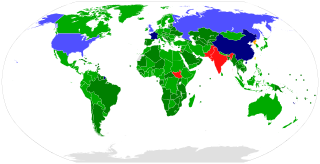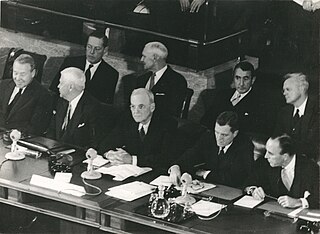Related Research Articles

The Environmental Modification Convention (ENMOD), formally the Convention on the Prohibition of Military or Any Other Hostile Use of Environmental Modification Techniques, is an international treaty prohibiting the military or other hostile use of environmental modification techniques having widespread, long-lasting or severe effects. It opened for signature on 18 May 1977 in Geneva and entered into force on 5 October 1978.

The Treaty on the Non-Proliferation of Nuclear Weapons, commonly known as the Non-Proliferation Treaty or NPT, is an international treaty whose objective is to prevent the spread of nuclear weapons and weapons technology, to promote cooperation in the peaceful uses of nuclear energy, and to further the goal of achieving nuclear disarmament and general and complete disarmament. Between 1965 and 1968, the treaty was negotiated by the Eighteen Nation Committee on Disarmament, a United Nations-sponsored organization based in Geneva, Switzerland.

The Partial Test Ban Treaty (PTBT), formally known as the 1963 Treaty Banning Nuclear Weapon Tests in the Atmosphere, in Outer Space and Under Water, prohibited all test detonations of nuclear weapons except for those conducted underground. It is also abbreviated as the Limited Test Ban Treaty (LTBT) and Nuclear Test Ban Treaty (NTBT), though the latter may also refer to the Comprehensive Nuclear-Test-Ban Treaty (CTBT), which succeeded the PTBT for ratifying parties.
Arms control is a term for international restrictions upon the development, production, stockpiling, proliferation and usage of small arms, conventional weapons, and weapons of mass destruction. Historically, arms control may apply to melee weapons before the invention of firearm. Arms control is typically exercised through the use of diplomacy which seeks to impose such limitations upon consenting participants through international treaties and agreements, although it may also comprise efforts by a nation or group of nations to enforce limitations upon a non-consenting country.

Disarmament is the act of reducing, limiting, or abolishing weapons. Disarmament generally refers to a country's military or specific type of weaponry. Disarmament is often taken to mean total elimination of weapons of mass destruction, such as nuclear arms. General and Complete Disarmament was defined by the United Nations General Assembly as the elimination of all WMD, coupled with the “balanced reduction of armed forces and conventional armaments, based on the principle of undiminished security of the parties with a view to promoting or enhancing stability at a lower military level, taking into account the need of all States to protect their security.”

The Conference on Disarmament (CD) is a multilateral disarmament forum established by the international community to negotiate arms control and disarmament agreements based at the Palais des Nations in Geneva. The Conference meets annually in three separate sessions in Geneva.
The Fissile Material Cutoff Treaty (FMCT) is a proposed international treaty to prohibit the further production of fissile material for nuclear weapons or other explosive devices. The treaty has not been negotiated and its terms remain to be defined. According to a proposal by the United States, fissile material includes high-enriched uranium and plutonium. According to a proposal by Russia, fissile material would be limited to weapons-grade uranium and plutonium. Neither proposal would prohibit the production of fissile material for non-weapons purposes, including use in civil or naval nuclear reactors.

The Geneva Summit of 1955 was a Cold War-era meeting in Geneva, Switzerland. Held on July 18, 1955, it was a meeting of "The Big Four": President Dwight D. Eisenhower of the United States, Prime Minister Anthony Eden of Britain, Premier Nikolai A. Bulganin of the Soviet Union, and Prime Minister Edgar Faure of France. They were accompanied by the foreign ministers of the four powers : John Foster Dulles, Harold Macmillan, Vyacheslav Molotov, and Antoine Pinay. Also in attendance was Nikita Khrushchev, de facto leader of the Soviet Union.

The United Nations Institute for Disarmament Research (UNIDIR) was established in 1980 by the United Nations General Assembly to inform States and the global community on questions of international security, and to assist with disarmament efforts so as to facilitate progress toward greater security and economic and social development for all.

The United Nations General Assembly First Committee is one of six main committees at the General Assembly of the United Nations. It deals with disarmament and international security matters.

The UN Office for Disarmament Affairs (UNODA) is an Office of the United Nations Secretariat established in January 1998 as the Department for Disarmament Affairs, part of United Nations Secretary-General Kofi Annan's plan to reform the UN as presented in his report to the General Assembly in July 1997.
The Eighteen Nation Committee on Disarmament (ENCD) was sponsored by the United Nations in 1961. The ENCD considered disarmament, confidence-building measures and nuclear test controls. Between 1965 and 1968, the ENCD negotiated the Treaty on the Non-Proliferation of Nuclear Weapons.
The Conference of the Committee on Disarmament was a United Nations disarmament committee authorized by a General Assembly resolution. It began work in 1969 as the successor to the Eighteen Nation Committee on Disarmament.

The International Day against Nuclear Tests is observed on August 29. It was established on December 2, 2009, at the 64th session of the United Nations General Assembly by the resolution 64/35, which was adopted unanimously.
Thomas Graham Jr. is a former senior U.S. diplomat. Graham was involved in the negotiation of every single international arms control and non-proliferation agreement from 1970 to 1997. This includes the Strategic Arms Limitation Talks, the Strategic Arms Reduction Treaties, the Anti-ballistic missile (ABM) Treaty, Intermediate-Range Nuclear Forces Treaty (INF) Treaty, Treaty on the Non-Proliferation of Nuclear Weapons Treaty (NPT), Treaty on Conventional Armed Forces in Europe (CFE) Treaty and Comprehensive Nuclear-Test-Ban Treaty (CTBT). In 1993, Ambassador Graham served as acting director of the Arms Control and Disarmament Agency (ACDA) from January to November, 1993 and Acting Deputy Director from November, 1993 to July, 1994. From 1994 through 1997, he was president Bill Clinton's special representative for Arms Control, Non-Proliferation, and Disarmament. Graham successfully led the U.S. government efforts to achieve the permanent extension of the NPT in 1995. Graham also served for 15 years as the general counsel of ACDA. Throughout his career, Thomas Graham has worked with six U.S. Presidents including Presidents Richard Nixon, Gerald Ford, Jimmy Carter, Ronald Reagan, George H. W. Bush, and Bill Clinton. Ambassador Graham worked on the negotiation of the Chemical Weapons Convention and the Biological Weapons Convention and managed the Senate approval of the ratification of the Geneva Protocol banning the use of chemical and biological weapons in war, as well as the Biological Weapons Convention.

The Treaty on the Prohibition of Nuclear Weapons (TPNW), or the Nuclear Weapon Ban Treaty, is the first legally binding international agreement to comprehensively prohibit nuclear weapons with the ultimate goal being their total elimination. It was adopted on 7 July 2017, opened for signature on 20 September 2017, and entered into force on 22 January 2021.
The Nuclear Freeze campaign was a mass movement in the United States during the 1980s to secure an agreement between the U.S. and Soviet governments to halt the testing, production, and deployment of nuclear weapons.

The Helsinki Summit (1990) was a private, bilateral meeting between American President George H. W. Bush and Soviet President Mikhail Gorbachev that took place in Helsinki, Finland on September 9th, 1990. Due to the vested interests of both the Soviet Union and the United States in the Gulf Crisis' resolution, August 1990 Iraqi invasion of Kuwait was the primary topic of discussion for the leaders during the Helsinki Summit. The concerted efforts at easing American-Soviet tensions in the aftermath of the Cold War was another prominent topic, among other notable current events. At the summit's conclusion, Presidents Bush and Gorbachev produced a document of joint statements that illuminated the areas in which the leaders had committed to aligning their foreign policy goals. The summit was followed by a press conference wherein members of the media questioned Presidents Bush and Gorbachev about the content of their meeting and the justifications for their joint statements.
The Prevention of an Arms Race in Outer Space document is a 1981 UN resolution that reaffirms the fundamental principles of the 1967 Outer Space Treaty and advocates for a ban on the weaponization of space."
References
- ↑ Blacker, Coit D., Duffy, Gloria, Stanford Arms Control Group. International Arms Control: Issues and Agreements, (Google Books link), Stanford University Press, 1984, pp. 109, ( ISBN 0804712115).
- 1 2 3 4 LeGault, Albert and Fortman, Michel. A Diplomacy of Hope: Canada and Disarmament, 1945-1988, (Google Books link), McGill-Queen's Press - MQUP, 1992, p. 170-73, ( ISBN 0773509550).
- ↑ Singh, Nagendra and McWhinney, Edward. Nuclear Weapons and Contemporary International Law, (Google Books link), Martinus Nijhoff Publishers, 1989, p. 231, ( ISBN 9024736374).
- ↑ Schaerf, Carlo, and Barnaby, Frank. Disarmament and Arms Control: Proceedings, Volume 1970, (Google Books link), Taylor & Francis US, 1972, p. 80, ( ISBN 0677152302).
- ↑ Legault, p. 170.
- 1 2 "Disarmament", The United Nations Office at Geneva, United Nations, 2009, accessed June 7, 2010.